Kriegsmarine WKC-made 2nd model Damascus Blade & Ivory Grip Officer’s Dagger
CATEGORY: Version
SKU: 21.GOR.04.01.08.002.000
Estimated market value:
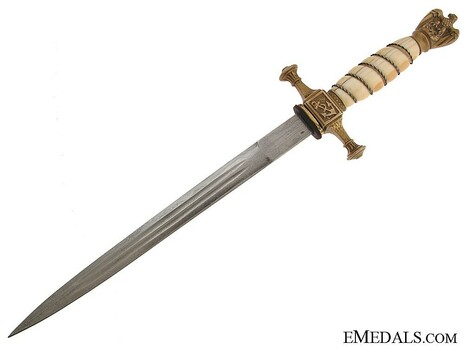
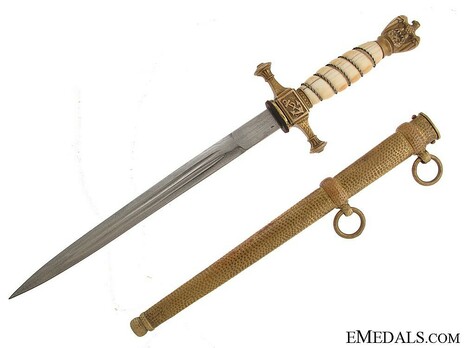
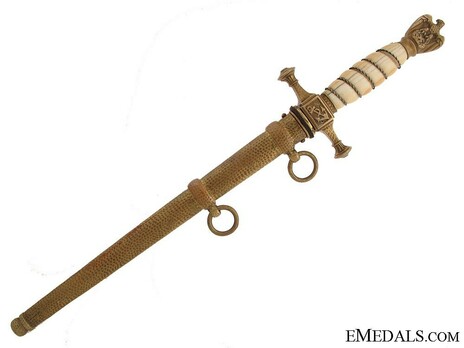
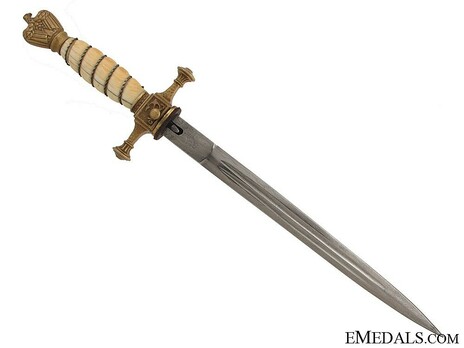
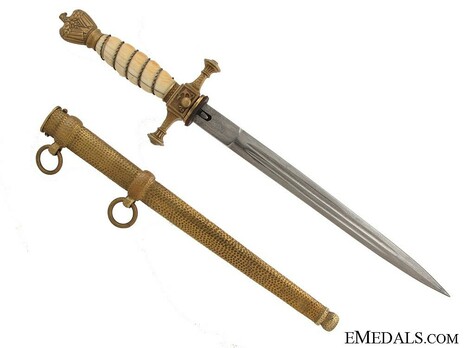
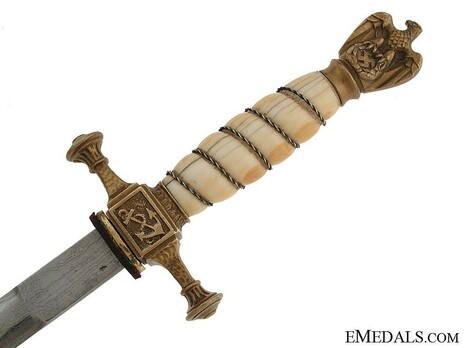
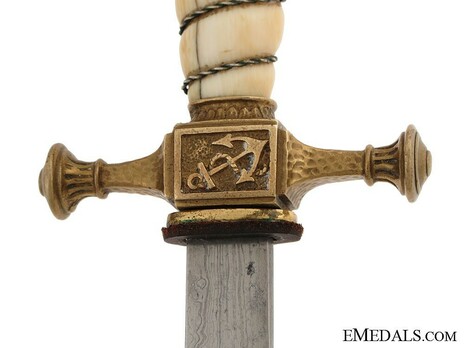
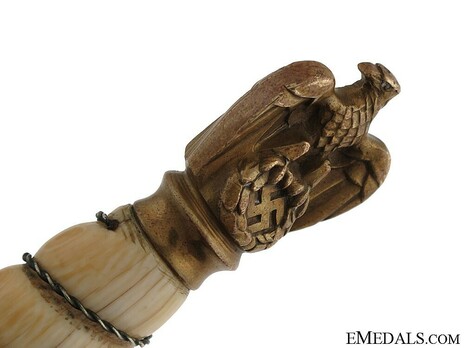
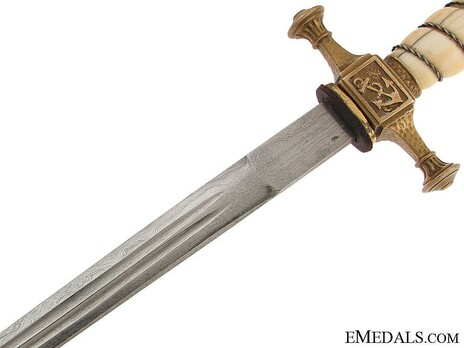
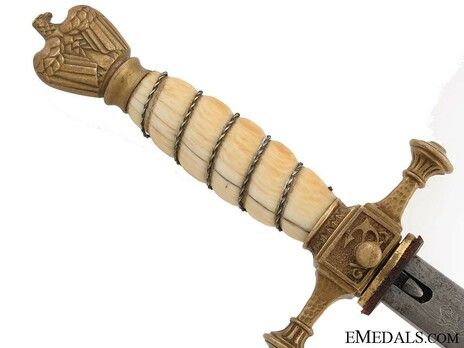
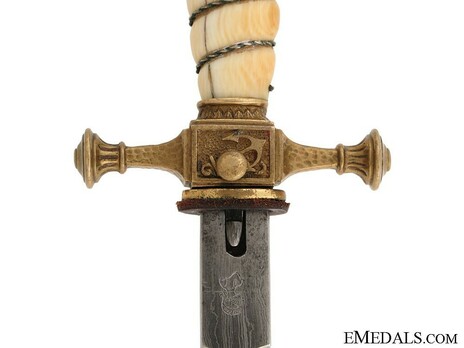
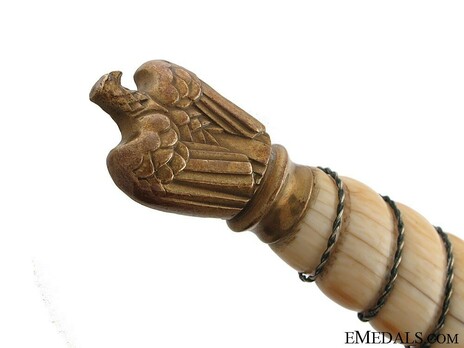
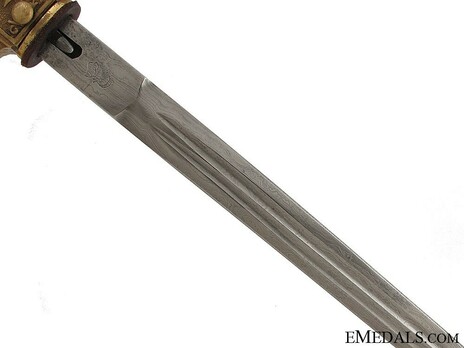
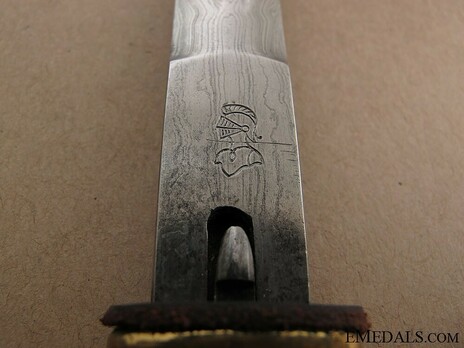
Estimated market value:
Navy Dagger with Ivory Grip & Damascus Blade - 2nd Model WKC Kriegsmarine Dagger, so called "Transitional" Type, with Ivory Grip and Genuine Damascus Blade; this is an early Kriegsmarine dagger, most likely manufactured circa 1910-15 period, and later fitted with a 1938 Third Reich style eagle and swastika pommel. The overall length of this dagger, with scabbard, is approximately 40.5cm (or 16 inches); blade length is approximately 24cm (or 9 ½ inches); gilded brass pommel exhibits moderate surface wear, it is nicely detailed, and shows pleasing old patina. The gilded-brass crossguard exhibits moderate wear, appears uncleaned, with pleasing look of old brass; the genuine ivory grip exhibits moderate surface wear, with nice age toning, while grip color ranges from light creamy to light golden; there are several minor hairline cracks visible on the twisted wire bound grip, but without chips or open cracks. Scabbard is of hammered gilded brass variety, with all of the gilding being worn off; there are few minor dents evident at the bottom of the scabbard, nothing major, hardly noticeable; the scabbard throat is retained by two screws. The genuine Damascus, WKC style "maiden-hair" pattern blade grades near excellent, exhibiting slight wear and age, with tiny nicks to cutting edges, while the tip is sharp and well defined; blade has excellent details to the Damascus pattern. Blade is stamped with so called "High-Neck", Knight's helmet (WKC) trade mark logo. Overall this dagger grades extremely fine; high quality, scarce and very attractive Kriegsmarine dagger.
The headgear, uniforms, and insignia worn by members of the Kriegsmarine were based upon the designs utilized by the Kaiserliche Marine (Imperial Navy) and the Reichsmarine of the Weimar Republic. The official regulations governing the uniforms of the Reichsmarine were issued on April 5, 1921, and they were embraced, with a few alterations, as the Kriegsmarine uniforms in 1935.
The general design of the Officer’s dagger used during the times of the Kaiserliche Marine and the Reichsmarine was employed in the manufacture of the daggers issued to members of the Kriegsmarine.
There were two main models of the Kriegsmarine Officer’s dagger and they are composed of several main elements, including the portepee, the scabbard, the locking mechanism, the dagger hangers, the pommel, the hilt, the wire wrapping, the crossguard, the blade, and the manufacturer mark.
Each model may or may not feature a portepee. The portepee, when present, is composed of aluminum bullion wire, and it should be tied in a “V” weave around the crossguard and hilt.
Both models of the Kriegsmarine Officer’s dagger are accompanied by a scabbard. The scabbard may feature a lightning bolt design with additional geometrics and linear designs, or a plain hammered “dimpled” design. Every scabbard has two bands, one at the top of the scabbard neck and the other almost at the middle of the scabbard. There is a suspension ring attached to each band to facilitate the attachment of dagger hangers.
The locking mechanism is featured on the reverse of the crossguard and is generally of a loaded locking button.
The dagger hangers are made from satin straps, gold-coloured lion mask buckles, and snap clips. Their basic design was unaltered between the two Kriegsmarine dagger models. However, a version of the dagger hangers was introduced after 1938 for wear by Administrative Officials, with the equivalent rank of Officer, with silver-coloured fittings. These silver-coloured buckles and clips may be composed of either silver or aluminum.
The 1st model of the Kriegsmarine Officer’s dagger is also known as the Reich Naval Dirk Model 1929, and they were issued from 1929-1938. These 1st model daggers have a “flaming ball” shaped pommel. The hilt is composed of white plastic (celluloid) in a spiral pattern with a gold-coloured brass wire placed in the swirl indents. The crossguard is composed of gold-coloured brass as well, and the obverse rectangle section of the crossguard has a fouled anchor; the reverse rectangle may or may not have a fouled anchor. The dagger’s blade is composed of steel and manufactured in a double-edged stiletto style, and there are no etchings on the blade surfaces. The dagger blade may be plated with nickel or silver.
The 2nd model of the Kriegsmarine Officer’s dagger was issued on January 28, 1938. The pommel of the 2nd model daggers is a Wehrmacht eagle with folded wings holding a swastika encircled by a wreath in its claws and with a left facing head. The hilt and the crossguard of the 2nd model utilize the same designs featured on 1st model daggers. In rare instances, the hilt of the dagger may be composed of ivory. The style of blade is identical between the 1st and 2nd model daggers.
The manufacturer mark is generally located at the top of the reverse blade below the crossguard.

Comments
Sign in to comment and reply.


Scroll Top